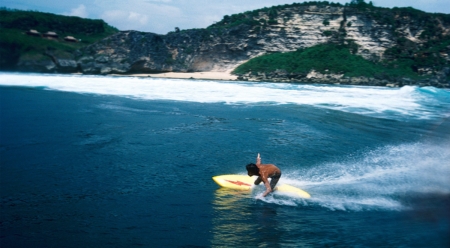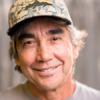The More Things Change: Gerry Lopez’s Uluwatu Talk Story
Gerry Lopez first surfed Uluwatu in 1974. The fabled Balinese wave was pristine, magical and empty (more on that below). Forty years later, he returned to host a yoga retreat, get a few waves between classes and help preserve Uluwatu for future generations. In this short film, Gerry uses Uluwatu and surfing as metaphors for change—and there’s a wider message that extends beyond the Bukit Peninsula, Bali and surfing. The More Things Change was directed by Nathan Myers and features surfing from Gerry Lopez, Dave Rastovich, Rob Machado and Rizal Tanjung.
Project Clean Uluwatu
In recent years, booming popularity has placed huge environmental pressure on the Uluwatu area. Project Clean Uluwatu is working to ease this pressure and restore the area’s pristine nature. Please donate to help keep this iconic place sacred and intact for locals and visitors alike: Project Clean Uluwatu.
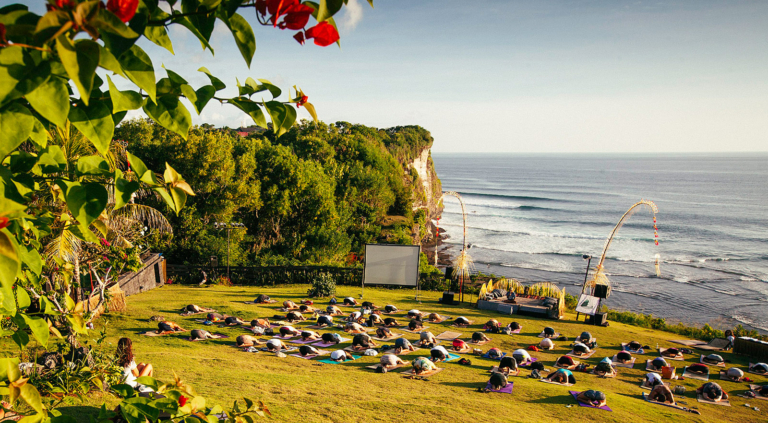
The setting for the yoga retreat definitely kicked asana. Bukit Peninsula, Bali. Photo: Tommy Schultz
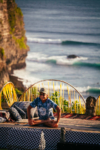
Gerry moves seamlessly from full lotus on the mat to full trim on his surfboard. Photo: Tommy Schultz
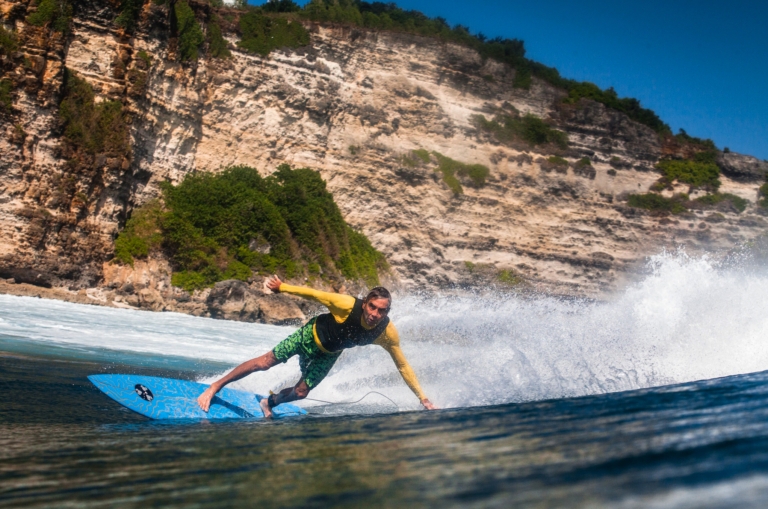
The more things change, the more they stay the same. Gerry surfing Uluwatu in 2015. Photo: Tommy Schultz
Uluwatu Unveiled (1974)
The first time to Uluwatu began with aspirations of a well-planned, precisely executed Special Forces assault on the surf. It quickly deteriorated into a fool’s mission right from the start. It was our second day in Bali, and we had seen few other tourists where we stayed in the sleepy village of Kuta Beach. There were a couple of hippie backpacker types, some older Australian couples, but no other surfers. Jack McCoy, who was a veteran of another trip here a year earlier, knew he could hire transport for us down on bemo corner.
As I followed him on the dirt road fronting our losmen accommodations, he explained that a bemo was a little Datsun or Toyota pickup truck with a canopy built over the bed and bench seats. Private cars were scarce. The occasional taxi was a late 1950s or early 1960s Chevy, painstakingly maintained but most likely still running on the original factory parts. Engines wheezing, rods knocking, mufflers shot, shocks long worn away. The American vehicles were lovingly cared for and polished at every idle moment to a high gloss, but they were much too big and overweight for the narrow, pot-holed, mostly dirt tracks and lanes.
Denpasar and the more built-up Sanur tourist areas might have been different, but in Kuta Beach time seemed to stand still. The few private vehicles we noticed were motorbikes of miniscule engine displacement but kept immaculately clean even after years and many miles of use. The consummate family ride featured father sporting an antique motorcycle helmet offering little or no protection doing the driving; mother in traditional sarong, wearing a construction hard hat offering much less protection sat side-saddle behind; with a youngster or sometimes two squeezed in between. It made quite a picture but the lack of traffic and the sedate pace of … well, everything, kept their world safe.
Bemo Corner was a busy place. Three bemos, their drivers and assistants, plus a half dozen bystanders, made for a huge crowd. Jack, towering over everyone by a foot or two, spread them apart by his immense presence and high-volume talk-show-host voice.
“I want to hire bemo all day,” he boomed.
His dad, ‘Big Jack McCoy,’ was a much-listened-to radio personality in Hawai‘i and young Jack had inherited the voice. Two of the drivers immediately found they were busy, but the third, with the oldest, most beat-up bemo perked up with interest. Jack and he put their heads together and exchanged a rapid-fire dialogue with much sign language, which I couldn’t follow but soon realized was a spirited negotiation. Jack came back to me, all smiles and shaka signs.
“Yeah man, we got him to take us out to Ulu and wait for us all day for 4,000 rups. He’s going to get gas and will come by our place in half an hour,” Jack informed me.
At 400 rupiah to the U.S. dollar and 600 to the Aussie dollar, I guessed ten bucks for a car all day was a pretty good deal. We went back to wake up Hakman, who was a late sleeper by nature, to tell him the good news and get our gear together.
We loaded our surfboards, some food, water, and ourselves into the back of our ride and off we went. It was early enough that most of the shops were still closed and the roads empty. The exhaust fumes blew directly into the back where we sat but we were too stoked to care. We passed the turnoff to the airport and were into new territory. At one point, shifting down into low gear, our little truck strained up a fairly steep hill. Looking out the back, a veritable sea of coconut trees stretched as far as we could see. On the left we had a brief view of a beautiful bay of jade-green water, with the airport runway on the far side and a wave breaking off the end of it. Jack informed us it was Jimbaran Bay and the high ground we were now on was the southern tip of Bali called the Bukit. At the end was an ancient temple inhabited by monkeys. There we would find the surf of Uluwatu. We had surfboards, we had food and water, we had plenty of stoke, and the waves were stacked to a horizon yet unseen.
We rolled through several little villages where everyone smiled and waved. We smiled and waved back. We saw a couple of other bemos headed the other way, their backs crammed with people. A few times we slowed down or stopped to let a man, or sometimes a very young boy, herd beautiful cows across the road using a long stick. The cows were golden-brown and white and looked more like beefy deer than bovines. No one seemed to be in a hurry except us.
Back then there weren’t many surfers around, and there were no signs or indications of where we would find Uluwatu. We drove to the end of the road and walked out to the deserted temple perched on the sharp point. It was a sheer drop to the water below, maybe 800 to 1,000 feet straight down. The temple must have been hundreds of years old and was deserted except for the occasional monkey flitting through the shrubbery. The surf looked great but disappeared out of sight around the point. Jack said he wanted to show us this place first, the southern-most tip of Bali, but that we needed to backtrack down the road to get to the surf spot of Uluwatu. An occasional track led off into the shrubs but they all looked the same. Jack had been here a year before but couldn’t remember which was the right track. Our driver and his assistant were no help, as neither had any idea what we were looking for nor was there anyone around to ask.
Finally we came to a track leading off the road that looked good to Jack. Our driver wanted to know when we would be back, and we guessed at about four to five hours. Except for us, the chirping of the birds, and bugs, there wasn’t anything else. We looked at Jack, shrugged our shoulders, grabbed our gear, and started down the track. The terrain was rugged limestone, full of hills and gullies, and the track was steep, crooked, and rough. It was a single track bordered with a thorny cactus-like plant that grew like a vine. We just followed where the track led. Up and down it went, back and forth, never in a straight line for very long, if ever. The thick walls of thorns didn’t allow much view, but the track seemed to be going somewhere. We came to an intersection and debated which turn to take.
Figuring the main road we came in on was more or less parallel to the coastline, we decided we needed to move at right angles to that. But the trail had twisted so much before the intersection it was hard to tell which way that was. We chose one and moved off. Soon we came to another trail crossing; again, neither way seemed headed toward the ocean. We took another guess and continued on. Before long it became apparent that we were headed back toward the road so we backtracked to the intersection and took the other way. After following this track for a while, it didn’t seem to be going where we wanted either.
Jeff climbed a nearby tree to get his bearings. It was a small tree, but I climbed up behind him. From this elevated view we could see the ocean in the distance and clambered back down with enthusiasm. Suddenly Jeff let out a screech, lifted up his shirt, searched himself, and plucked off a tiny, black ant. Then one bit me rather painfully, I peeled off my tee shirt and Jack jumped in to help us brush the ants off. Jeff held one of the tiny creatures up between his fingers, exclaiming, “How can such a small ant have such a large bite?”
This was our introduction to the insect life of Indonesia, a study that would fascinate us over the next twenty-five years of discovering and marveling at the many strange types.
Knowing which way the ocean was didn’t seem to be much help, as the trail wouldn’t head that direction. I had the idea that we should breach the thorny trail boundary and cross-country it. This met with the approval of both Jack and Jeff, since we sure weren’t getting any closer the way we were going. We walked along until we found a light place in the thorns, moved some aside and slipped through.
The other side was a huge, open space, like a pasture except without much grass. It was an empty field, so the going was easy, and we happily headed the way we wanted to go. This didn’t last long, as we soon came to the end of the open area and met with another thorn wall. Finding an opening to get through was more difficult, but after breaking our way past the thorns, we were on another track headed somewhere, but not toward the ocean.
We had been walking for over an hour and a half, and were hot, sweaty, ant-bitten, and out of patience. Going back wasn’t an option either; we had to admit we were lost. Just when it seemed like we might start going for each other’s throats, we heard someone coming. Around the corner came three surfers who looked like they knew where they were going. Introductions made, we found ourselves with three Maui boys, brothers Mike and Bill Boyum and Fred Haywood. It was a chance beginning to a lifelong friendship and many shared adventures.
Finally, with the new leadership, we arrived at the cliff overlooking the waves. It was as magnificent a sight as any surfer could behold. Perfect lines swept by clean offshore winds rolled in, peaked up and peeled off, occasionally hollowing out, spitting spray and continuing to peel off further. Jeff, Jack, and I blinked our eyes, blinked again, looked back, and realized we weren’t seeing things. This was real and except for Mike, Bill, and Fred, there wasn’t another soul around. We had just walked up to the gateway of paradise.
Excerpted from Surf Is Where You Find It (Revised and Expanded) by Gerry Lopez. Available now from Patagonia Books.
